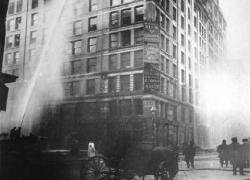1000 N. West Street #1200, Wilmington, DE 19801
© 2024 Direct Learning Systems, Inc. All rights reserved.

As writers, we aim to create vivid “word pictures” that transport readers into a fiction or nonfiction “world” when writing a novel or article. When we do it well, readers see those pictures in their minds and want to spend time in the worlds we create for them. For narrative nonfiction writers, this means describing people, places, objects, and events in accurate and imaginative ways. Besides offering information, we can entertain, inspire, and trigger emotional responses in our readers.
One vital tool for achieving those goals is the use of imagery, meaning words and phrases that appeal to people’s senses and help them form mental pictures as they read. The sense of sight often comes to mind first, but other senses are equally important: sound, smell, taste, and touch—both texture and temperature (sometimes called “thermal details”). Other images reveal action/motion.

Besides appealing to the senses, imagery can express something in fewer words and add variety and interest. In Beyond Style: Mastering the Finer Points of Writing, Gary Provost lists additional benefits: “Sometimes the right image creates a mood we want. Sometimes an image can suggest connections between two things. Sometimes an image can make a transition smoother. We use images to show intention. (Her words were fired in a deadly monotone and she gunned down the three of us with her smile.) We use imagery to exaggerate. (His arrival in that old Ford always sounded like a six-car pileup on the Harbor Freeway.) Sometimes we don’t know why we’re using imagery; it just feels right.”
As Aristotle once pointed out, nothing reaches the mind without first passing through the senses. Author Don Ranly therefore urges authors to “be the ears, the eyes, the nose of your readers.”
What makes sensory description such a powerful writing tool? In Imaginative Writing, Janet Burroway cites the role of physiology. She writes, “Information taken in through the five senses is processed in the limbic system of the brain, which generates sensuous responses in the body: heart rate, blood/oxygen flow, muscle reaction, and so forth. Emotional response consists of these physiological reactions, so in order to have an effect on your reader’s emotions, you must literally get into the limbic system, which you can only do through the senses.”
Successful writers learn how to bring in diverse senses, use concrete analogies, and choose language that is specific, not vague or general. For example, does your travel article mention “a tree,” or is it a flowering dogwood, a bristly hemlock, or a towering, bare-branched oak? Is the person you’re profiling wearing a blue shirt, or is it navy, cobalt, or powder blue? Do you describe the smell and touch details at the amusement park as well as the sights, sounds, and tastes?

Nonfiction writers often take readers to unfamiliar places as well as other times in history Sensory details are essential in bringing those places to life, especially when they are new to readers. But familiar settings merit vivid imagery, too. In The Golden Circle, Hal Borland describes a time of year. What do you think he wants you to see, hear, and feel?
“October is a time of far and misty horizons that beckon, a time of crow-caw and jay-jeer, before the slash of sleet or the gentle fall of snow. It is frost creeping down from the hills in moccasin-quiet feet to dust the valleys with glitter, of wind skittering down the road in a scuffling of leaves, of owl hoot and fox bark in the moonlight.”
In his memoir Hole in the Sky, William Kittredge brings a person to life while describing a childhood experience at his grandmother’s home during Thanksgiving dinner:
“I was seated on a couple of books in a straight-backed chair beside my great-uncle Hank, a dim, lank old alcoholic bachelor with a whiskery beard. Uncle Hank was munching along in his silent way when he muttered some unintelligible thing and pulled his complete set of false teeth from his mouth, setting them out to dry on the fine white linen tablecloth. Hank’s teeth were inextricably tangled with long strings of bright green spinach. They sat there damp and alive, staining the linen cloth, while he went on eating. I began whimpering…and there was a scene.”
Experts warn writers not to overwrite or pile on too much description. As with any writing, we make careful choices based on our subject matter and purpose. We can give enough details to create an image while leaving space for the reader’s own imagination. Author Terri Brooks chose a few telling visuals to convey the appearance and mood of a hospital lounge: “The décor is tight budget. Furniture is covered in vinyl and burns from cigarettes that missed the plastic ashtrays. Draperies sometimes sag as if they have seen too much.”

“When firefighters and policemen finally went inside the building, they found blackened skeletons of workers bent over their machines. Thirty-six workers lay inside an elevator shaft…. Among the ashes on the eighth floor, firefighters found twenty-four wedding and engagement rings. When the medical examiner saw the young victims, he sobbed.”
These lines highlight the fact that victims died trapped in the rooms where they had labored for their meager living. I put readers in the “shoes” of the firefighters who found the wedding and engagement rings—signs that these women had families and people who loved them, and that young lives were cut short. The medical examiner’s reaction shows, without graphic details, such heart-wrenching sights that a man who had witnessed many tragedies during his career openly sobbed.
To hone your skills in creating images, become a keen observer and practice describing things. It can be an animal in your backyard, the meal you just ate, a building down the street, a seashell, moss on the forest floor, and your emotions during various situations. Devise fresh ways of expressing yourself instead of relying on clichés. As part of your writing practice, make a list of trite phrases like the ones below and create your own.
-as good as gold
-sparkling like diamonds
-mad as a wet hen
-teeth like pearls
-hungry as a bear
-smart as a whip
-quiet as a mouse
-spinning like a top
Through study and practice, you, too, can appeal to your readers’ senses with vivid imagery. Readers will appreciate the extra care and artistry you bring to your work, and they’ll look forward to more.
Want to work more imagery into your manuscripts? Let our one-one instructors show you how! Take our assessment and be matched with a mentor to fit your goals!
Victoria Sherrow has published short stories, articles and books (fiction and nonfiction) for readers aged preschool through adult. Her books have received starred reviews and been honored by the American Library Association, Parents Choice Gold Award, National Association for the Advancement of Science, and NYPL Best Books for the Teenage, among others. Victoria has taught at The Institute of Children’s Literature for more than 25 years and has also been an assistant editor and writing contest judge. Recently, she revised and polished a 230,000-word book for adults.
1000 N. West Street #1200, Wilmington, DE 19801
© 2024 Direct Learning Systems, Inc. All rights reserved.
1000 N. West Street #1200, Wilmington, DE 19801
© 2024 Direct Learning Systems, Inc. All rights reserved.
1000 N. West Street #1200, Wilmington, DE 19801
© 2024 Direct Learning Systems, Inc. All rights reserved.
1000 N. West Street #1200, Wilmington, DE 19801
© 2025 Direct Learning Systems, Inc. All rights reserved.
1000 N. West Street #1200, Wilmington, DE 19801
©2025 Direct Learning Systems, Inc. All rights reserved. Privacy Policy.
1 Comment